How Rubin Works
Rubin Observatory will revolutionize the way we explore the cosmos. Using the largest camera ever built to repeatedly scan the sky for 10 years, Rubin will produce an ultra-wide, ultra-high-definition, time-lapse view of our Universe. Learn how Rubin works below!
Bringing the night sky to life
Over the next decade, Rubin Observatory’s Legacy Survey of Space and Time (LSST) will capture the southern sky in extraordinary detail, building the most complete time-lapse of the cosmos ever created.
Powered by innovative technology
Rubin Observatory is packed with innovative technology, from a one-of-a-kind combined primary/tertiary mirror to the largest camera ever built. Explore the technology that makes Rubin science possible.
The Alert Stream
Rubin will detect millions of changes in the southern sky every night, and issue a world-public alert for each change within minutes, allowing scientists to quickly follow up.
Key Numbers
- Primary mirror diameter
- 8.4meters
- Secondary mirror diameter
- 3.5meters
- Field of View
- 3.5º(10 degrees2)
- LSST Camera height
- 1.65meters
- LSST Camera length
- 3.65meters
- LSST Camera resolution
- 3200Megapixels
- Generated data volume
- 20TBper night
- Stars & galaxies detected
- 37billionin total
- Number of alerts
- 10millionper night

